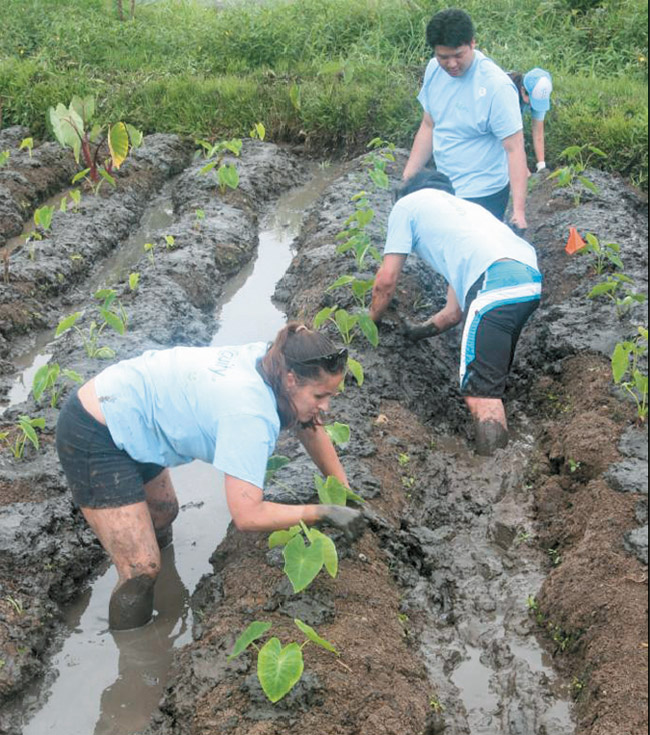He‘eia Ahupua‘a: The Place Where Mud And Culture Meet

Accuity employee volunteers assist in preparing new taro patches June 7 on the company's annual 'Accuity Cares' day at the He'eia Wetlands. Delilah Irvine (front) and Sean Mochizuki (back) worked on the restoration efforts there while taking on plenty of mud for themselves. Photo from Taryn Nakamura.
Windward Oahu’s wet and muddy cultural sites continue to attract eager office workers from town for community service projects. In one summer weekend alone, a total of 240 employees and families from two companies got down and dirty at both ends of the He’eia ahupua’a – all in the name of sustainability.
Accuity, one of the state’s largest accounting firms, brought about 40 workers down to the He’eia Wetlands one day in June to help the nonprofit Kako’o ‘Oiwi restore taro patches. And the next day, 200 Hawaiian Electric Co. employees and their families reported to work at Papahana Kuaola in Waipao, He’eia (mauka of Haiku Road) to garden and put up building frames.
“Our annual ‘Accuity Cares’ day is one of our company’s most cherished traditions,” said managing partner Kent Tsukamoto, “and we are honored to work with Kako’o ‘Oiwi this year. Our community service day is an opportunity to unite as a team as we show our appreciation for the land and the traditions that make Hawaii unique.”
The employees worked in the garden or taro patches, clearing weeds and doing other tasks to build and maintain the area. Kako’o ‘Oiwi has a 38-year lease from Hawaii Community Development Authority to restore agricultural and ecological productivity to nearly 405 acres of the He’eia wetlands, stretching from Kamehameha Highway to Kahekili Highway.
“Papahana Kuaola was able to accommodate a large group and welcomed volunteers of all ages, which allowed us to have our biggest volunteer event this year,” said Briana Ackerman of HECO’s education and consumer affairs department. “About 200 of us were able to gather for a good cause and learn traditional Hawaiian practices.”
The theme for its June 8 project was “sacred spaces,” as the HECO group worked to improve the 70-acre kauhale, a traditional model of sustainable living. They created gardens for rare varieties of banana trees, gathered and debarked guava wood for construction, bundled pili grass for roof thatching, cleaned the taro patch and planted native trees during a four-hour period in the lush mauka jungle.
“Workdays like this are awesome,” declared Matthew Schirman, program director for the nonprofit Papahana Kuaola, which provides an educational experience for some 30,000 schoolchildren each year. More important than the work accomplished, Schirman noted, was putting modern life aside to spend time with nature. “Getting people outdoors in the environment in a place that make them feel relaxed and welcome – it has a really good effect on them.”





